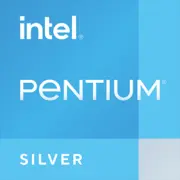Intel Pentium Silver N5030

Intel Pentium Silver N5030: Budget Processor for Everyday Tasks
Analysis of capabilities, use cases, and practical recommendations
Architecture and Technology Process: Balance Between Economy and Basic Performance
The Intel Pentium Silver N5030 belongs to the Gemini Lake Refresh generation, manufactured using the outdated 14nm technology process. This is a 4-core processor without support for hyper-threading (4 threads), which is typical for budget solutions. Its base frequency is 1.1 GHz, with a temporary boost up to 3.1 GHz in turbo mode.
Architecture Features:
- Cores Based on Goldmont Plus Microarchitecture: Optimized for energy efficiency but not for high performance.
- Integrated Graphics Intel UHD Graphics 605: 18 execution units (EUs), frequency up to 750 MHz. Supports 4K output via HDMI 2.0, but is not designed for 3D rendering.
- Cache Memory: 4 MB L3 — a minimal amount for handling simple tasks without frequent accesses to RAM.
Why 14nm in 2025?
Despite Intel's shift to 10nm and 7nm processors, Gemini Lake Refresh maintains its position in ultra-budget laptops. This helps lower the cost of devices but limits potential in multi-threaded tasks.
Power Consumption and TDP: Quiet Operation and Compactness
The processor's TDP is only 6W, making it ideal for:
- Laptops with passive cooling (fanless).
- Ultra-portable devices (e.g., 11–13 inch hybrids).
Practical Advantages:
- No noise: suitable for libraries, offices.
- Minimal heating: the laptop can be used on the lap without discomfort.
However, the low TDP also means limitations: during prolonged workloads (e.g., video rendering), the frequency drops to the base 1.1 GHz to avoid overheating.
Performance: What Can the Pentium Silver N5030 Do?
Geekbench 6 Assessment:
- 411 points (single-core test): Slower than the Intel Core i3 10th generation (about 1200 points), but sufficient for office tasks.
- 868 points (multi-core test): Comparable to the AMD Athlon Silver 3050U (850–900 points).
Real-World Scenarios:
1. Office Work:
- Smooth operation with Google Docs, Microsoft Office.
- Simultaneous opening of 10–15 tabs in Chrome (with 8 GB of RAM).
Issues: Lag when working with heavy Excel spreadsheets or PDF files.
2. Multimedia:
- Watching 4K videos on YouTube (with hardware acceleration).
- Basic photo editing in Lightroom, but export will take 2-3 times longer than on a Core i5.
3. Gaming:
- 2010s games at low settings: Minecraft (40–50 FPS), CS:GO (30 FPS).
- Cloud gaming (GeForce NOW, Xbox Cloud) is an optimal option.
Turbo Boost: Burst up to 3.1 GHz lasts for 10–15 seconds, which is useful for opening applications but not for long-term loads.
Use Cases: Who Is This Processor For?
1. Students: For text work, online courses, Zoom conferences.
2. Seniors: Simple interface, long battery life, no maintenance difficulties.
3. Secondary Device: For example, a compact laptop for travel.
Not Suitable For:
- Video editing, 3D modeling.
- Modern gaming (except for browser-based and retro projects).
Battery Life: Up to 12 Hours of Work?
With a 42 Wh battery (typical for budget models), the working time reaches 8-10 hours in modes such as:
- 50% screen brightness.
- Working in the browser, viewing PDFs.
Energy-Saving Technologies:
- Intel Speed Shift: Quick switching between processor states.
- Panel Self Refresh: Reduces load on GPU when displaying a static image.
Tip: Choose laptops with low-power IPS matrix screens (e.g., resolution of 1366x768 instead of Full HD).
Comparison with Competitors: Who's Better?
1. AMD Athlon Silver 3050e (Zen):
- Similar price ($250–$350), but better performance in multi-threaded tasks (thanks to Zen architecture).
- Cons: TDP of 6W vs. 6W for Intel, but poorer optimization for Windows.
2. Apple M1 (in MacBook Air):
- Performance 3-4 times higher, but price starts at $999.
- Pentium N5030 is a choice for those who are price-conscious.
3. Intel Celeron N4500 (2023):
- Less powerful (2 cores) but cheaper by $50–$70.
Conclusion: The N5030 is a reasonable compromise if you need a new laptop for under $300.
Pros and Cons
Strengths:
- Low device prices ($250–$400).
- Quiet operation (no cooler).
- Support for 4K video.
Weaknesses:
- Low performance in resource-intensive tasks.
- Outdated technology process (14 nm).
- No support for PCIe 4.0, Thunderbolt.
Laptop Selection Recommendations
1. Optimal Models:
- Lenovo IdeaPad Flex 3 11-inch ($279): Touchscreen, 8 GB of RAM.
- Acer Aspire 1 A115-32 ($299): Full HD display, 256 GB SSD.
2. What to Look For:
- RAM: Minimum of 8 GB (4 GB in 2025 will be a struggle).
- Storage: Only SSD (even 128 GB is better than HDD).
- Screen: 1920x1080 resolution is a nice bonus but not mandatory.
3. What to Avoid:
- Versions with HDD.
- Laptops without USB-C (for future compatibility).
Final Conclusion: Who Is the Pentium Silver N5030 For?
This processor is a choice for those who:
- Seek the most affordable laptop for basic tasks.
- Value silence and long battery life.
- Do not plan to run “heavy” applications.
Key Benefits:
- Price under $300.
- Ability to work without recharging all day.
- Sufficient for 90% of everyday tasks (browsing, office, video).
If your budget allows for $500+, consider laptops with Intel Core i3 12th generation or AMD Ryzen 3 7300U processors — they will last longer and not disappoint in performance.
Basic
CPU Specifications
Memory Specifications
GPU Specifications
Miscellaneous
Benchmarks
Compared to Other CPU
Share in social media
Or Link To Us
<a href="https://cputronic.com/cpu/intel-pentium-silver-n5030" target="_blank">Intel Pentium Silver N5030</a>